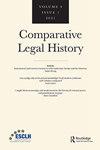现代早期瑞典的自杀、法律与社区
IF 0.5
Q2 LAW
引用次数: 0
摘要
Riikka Miettinen的第一本书对“早期现代强势国家的神话”进行了有力的打击(9)。在法律史学界,早期现代最著名的是司法革命,它见证了从地方和社区管理的恢复性司法向基于报复性司法的系统的转变,由中央集权和官僚化的国家自上而下实施,并雇用了受过大学教育的精英司法人员。这里争论的是,这种转变在多大程度上赋予了国家权力,并允许对其臣民及其价值观进行控制。马修·洛克伍德(Matthew Lockwood)最近出版的《征服死亡:暴力与现代英国国家的诞生》(Conquest of Death: Violence and the Modern england State)等研究认为,这种转变是一个威权国家以铁腕控制其人口的发展不可或缺的一部分,而米蒂宁(Miettinen)则证明了早期现代瑞典王国的理想是完全不可能实现的。这个王国不仅人口稀少,90%的人口居住在偏僻的乡村,而且是一片多元化的土地。包括芬兰和克克斯霍尔姆在内,这个王国的居民语言多样(讲瑞典语、芬兰语和俄语),宗教多样(路德教、东正教和Sámi人的万物有灵论信仰)。米蒂宁以自杀罪为切入点,强调了在这一关键时期,地方和社区的正义是如何继续存在的。大部分历史文献都集中在对自杀的态度上,因此米蒂宁从第二章开始(引言是第一章)是合适的。瑞典在将自杀定为刑事犯罪方面起步较晚:直到1442年被称为“克里斯托弗国王法”的法典通过后,自杀才被视为刑事犯罪。与欧洲各地的典型做法一样,该法律建议对尸体施加羞辱性惩罚,以引起人们对重罪犯被遗弃状态的关注。所规定的刑罚的性质取决于他或她在死亡时的心境:理智的自杀被判处本文章由计算机程序翻译,如有差异,请以英文原文为准。
Suicide, law, and community in early modern Sweden
Riikka Miettinen’s fine first book strikes a powerful blow to the ‘myth of early modern strong states’ (9). In legal historical circles, the early modern era is best known for its Judicial Revolution, which witnessed a transition from restorative justice administered locally and communally to a system based on retributive justice, imposed top-down by a centralized and bureaucratized state, and which employed an elite, university-educated judicature. What is at debate here is the extent to which this transition empowered the state and permitted control over its subjects and their values. While studies like Matthew Lockwood’s recent Conquest of Death: Violence and the Birth of the Modern English State see this transition as integral to the development of an authoritarian state controlling its population with an iron grip, Miettinen demonstrates the sheer impossibility of the ideal for the early modern Kingdom of Sweden. Not only was the kingdom sparsely populated, with 90% of its population living in isolated rural hamlets, it was a land of diversity. Including also Finland and Kexholm, the realm’s inhabitants were linguistically diverse (speaking Swedish, Finnish and Russian) and religiously diverse (Lutheran, eastern Orthodox and the animistic faith of the Sámi people). Miettinen uses the crime of suicide as a gateway to underscore just how local and communal justice continued to be during this crucial period. The bulk of the historical literature has focussed on attitudes towards suicide, and thus it is appropriate that Miettinen begins there with Chapter Two (the Introduction being Chapter One). Sweden was late to the game when it comes to the criminalization of suicide: it was not counted as such until the code known as King Christopher’s Law passed in 1442. As is typical across Europe, the law recommended shaming punishments imposed upon the corpse to draw attention to the felon’s outcast state. The nature of the penalty prescribed depended upon his or her peace of mind at the time of death: sane suicides were sentenced to
求助全文
通过发布文献求助,成功后即可免费获取论文全文。
去求助
来源期刊
CiteScore
1.70
自引率
0.00%
发文量
20
期刊介绍:
Comparative Legal History is an international and comparative review of law and history. Articles will explore both ''internal'' legal history (doctrinal and disciplinary developments in the law) and ''external'' legal history (legal ideas and institutions in wider contexts). Rooted in the complexity of the various Western legal traditions worldwide, the journal will also investigate other laws and customs from around the globe. Comparisons may be either temporal or geographical and both legal and other law-like normative traditions will be considered. Scholarship on comparative and trans-national historiography, including trans-disciplinary approaches, is particularly welcome.

 求助内容:
求助内容: 应助结果提醒方式:
应助结果提醒方式:


